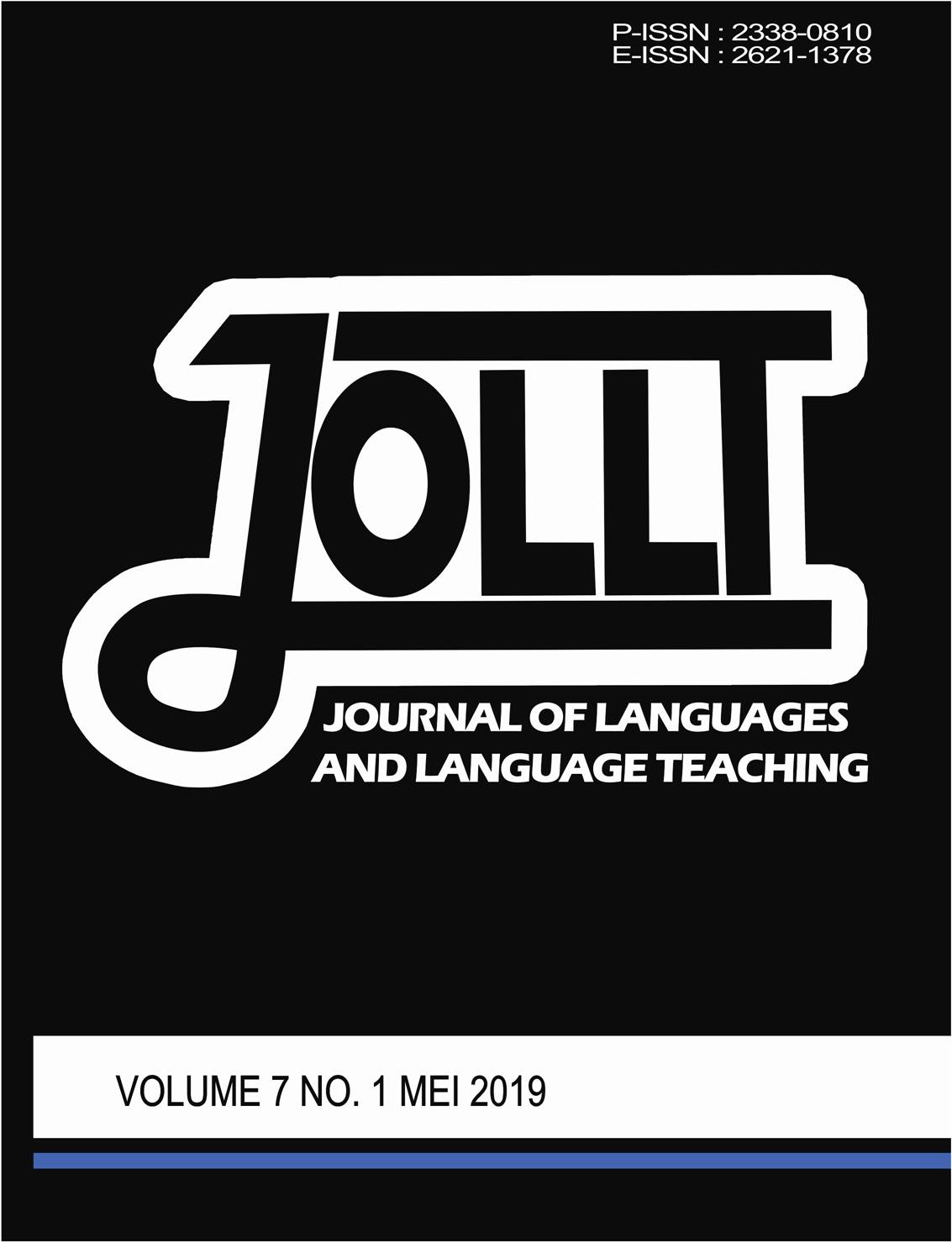IMPROVING XI-GRADE STUDENTS’ WRITING ESSAY SKILL USING COMPUTER EDUTAINMENT
DOI:
https://doi.org/10.33394/jollt.v7i2.1957Keywords:
Teaching Writing, Computer EdutainmentAbstract
References
Amory, A. (2007). “Game Object Model Version II: A Theoretical Framework for Educational Game Developmentâ€. Educational Technology Research and Development, 55(1), 55–77.
Brown, H.D. (2001). Teaching by Principles: An Interactive Approach to Language Pedagogy (2nd. Ed.). New York: Pearson Edition Company.
Brumfit, J. & Keith J. (Eds.). (1983). The Communicative Approach to Language Teaching. Oxford: Oxford University Press.
Buckingham, D. & Scanlon, M. (2000). That is Edutainment: Media, Pedagogy and the Market Place. Paper presented to the International Forum of Researchers on Young People and the Media, Sydney. In Okan, Zühal (2003). Edutainment: is learning at risk?. British Journal of Educational Technology, 34 (3), 255–264.
Butler-Pascoe, (1990). Effective uses of computer technology in the development of writing skills of students enrolled in a college- level English as a Second Language program. Published doctoral dissertation, United States International University, California.
Cornbleet & Carter. (2001). The Language of Speech and Writing. London and New York: Routledge. In Amen, Randa Atef (2008).The effectiveness of using the guided discovery method using pictures in developing the writing skills of the primary school students. Unpublished master dissertation, Educational studies institute, Cairo University.
Dehaan, (2008). Video Games and Second Language Acquisition: The effect of interactivity with a rhythm video game on second language vocabulary recall, cognitive load, and telepresence. Published doctoral dissertation, New York University, United States, New York.
DeKanter, (2005).Gaming Redefines Interactivity for Learning. Association of Educational communication& Technology, 49(3).
Dickey, Michele D. ( 2006). Game design and learning: a conjectural analysis of how massively multiple online role-playing games (MMORPGs) foster intrinsic motivation. Education Technology Research Development.
Deleveaux, (2007). Critical Edutainment: An in-depth look at informal education at one facility. Published Doctoral Dissertation, Faculty of Education, McGill University.
Dempsey, J. & Casey M. (2002). Forty Simple Computer Games and What They Could Mean to Educators. Simulation and Gaming, 33(2), 157-168.
Goldberg, A. Russell M., & Cook A. (2003). The Effects of Computers on Student Writing: A meta-analysis of studies from 1992-2002. The Journal of Technology Learning, and Assessment, 2(1), 1-51.
Green, M., McNeese, N. (2007) Using Edutainment software to enhance online learning. International Journal of E-Learning, 6(1), 5–16.
Haerazi, H., Irwansyah, D., Juanda, J., & Azis, Y. A. (2018). Incorporating Intercultural Competences in Developing English Materials for Writing Classes. Journal of Language Teaching and Research, 9(3), 540-547. http://dx.doi.org/10.17507/jltr.0903.13
Haerazi, H., & Irawan, L. A. (2019). Practicing Genre-Based Language Teaching Model to Improve Students’ Achievement of Writing Skills. IJELTAL (Indonesian Journal of English Language Teaching and Applied Linguistics), 4(1), 9-18. http://dx.doi.org/10.21093/ijeltal.v4i1.246
Jacobs, Geralyn. (1993). A Classroom Investigation of the Growth of Metacognitive Awareness in Kindergarten Children Through the Writing Process. Published doctoral dissertation, University of south Dakota
Jupri, J. (2018). Using video recipe to improve the junior high school students’ ability in writing procedure text. JOLLT Journal of Languages and Language Teaching, 6(2), p. 108-115. https://doi.org/10.33394/jollt.v6i2.1262
Meyers, Kimberly. (2008). A Structured Imagery Intervention to Improve Students' Narrative Writing Skills. Published doctoral dissertation, published dissertation, Alfred University.
Meyers, C., & Jones, T. B. (1993).Promoting active learning: Strategies for the college classroom. San Francisco, CA: Jossey-Bass.
Pour, M. (2006). Emerging Trends and Challenges in Information Technology Management. Idea group inc.
Prensky, M. (2002). The Motivation of Gameplay or, the Real 21st Century Learning Revolution. On The Horizon.10(1).5-11.
Ramsey, Lan et al. (2006). Endocrine Evaluation, Yusuf Pisan publisher.
Richards, J. C. and Renandya, W. A. (Eds). (2002). Methodology in language Teaching: An Anthology of Current Practice. Cambridge: Cambridge University Press.
Seow, A. (2002). The Writing Process and Process Writing. In Richards, J. C. and Renandya, W. A. (Eds). (2002). Methodology in Language Teaching: An Anthology of Current Practice. Cambridge: Cambridge University Press.
Soreensen, H., et al., (2002). Learning and Narativity in Digital Media. Samfunds Literature.
Swan, Richard Heywood. (2008). Deriving Operational Principles for the Design of Engaging Learning Experiences. Published doctoral dissertation, Brigham Young University.
The New penguin English dictionary. (2000). London: Penguin Books, P.444.
Tuzun, Hakan. (2004). Motivating Learners in Educational Computer Games. Published Doctoral Dissertation, Indiana University, United States Indiana.
Downloads
Published
How to Cite
Issue
Section
Citation Check
License
License and Publishing Agreement
In submitting the manuscript to the journal, the authors certify that:
- They are authorized by their co-authors to enter into these arrangements.
- The work described has not been formally published before, except in the form of an abstract or as part of a published lecture, review, thesis, or overlay journal.
- That it is not under consideration for publication elsewhere,
- That its publication has been approved by all the author(s) and by the responsible authorities – tacitly or explicitly – of the institutes where the work has been carried out.
- They secure the right to reproduce any material that has already been published or copyrighted elsewhere.
- They agree to the following license and publishing agreement.
Copyright
Authors who publish with JOLLT Journal of Languages and Language Teaching agree to the following terms:
- Authors retain copyright and grant the journal right of first publication with the work simultaneously licensed under a Creative Commons Attribution License (CC BY-SA 4.0) that allows others to share the work with an acknowledgment of the work's authorship and initial publication in this journal.Â
- Authors are able to enter into separate, additional contractual arrangements for the non-exclusive distribution of the journal's published version of the work (e.g., post it to an institutional repository or publish it in a book), with an acknowledgment of its initial publication in this journal.
- Authors are permitted and encouraged to post their work online (e.g., in institutional repositories or on their website) prior to and during the submission process, as it can lead to productive exchanges, as well as earlier and greater citation of published work.
Licensing for Data Publication
- Open Data Commons Attribution License, http://www.opendatacommons.org/licenses/by/1.0/ (default)
This work is licensed under a Creative Commons Attribution-ShareAlike 4.0 International License.

















